 |
| An occluded
mesocyclone tornado (Oklahoma, May 1999). |
Wind
Wind is the flow of gases on a large scale. On the
surface of the Earth, wind consists of the bulk movement
of air. Winds are commonly classified by their spatial
scale, their speed, the types of forces that cause them,
the regions in which they occur, and their effect. The
strongest observed winds on a planet in the Solar System
occur on Neptune and Saturn. Winds have various aspects:
velocity (wind speed); the density of the gas involved;
energy content or wind energy. The wind is also an
important means of transportation for seeds and small
birds; with time things can travel thousands of miles in
the wind. In meteorology, winds are often referred to
according to their strength, and the direction from
which the wind is blowing. Short bursts of high speed
wind are termed gusts. Strong winds of intermediate
duration (around one minute) are termed squalls.
Long-duration winds have various names associated with
their average strength, such as breeze, gale, storm, and
hurricane. Wind occurs on a range of scales, from
thunderstorm flows lasting tens of minutes, to local
breezes generated by heating of land surfaces and
lasting a few hours, to global winds resulting from the
difference in absorption of solar energy between the
climate zones on Earth. The two main causes of
large-scale atmospheric circulation are the differential
heating between the equator and the poles, and the
rotation of the planet (Coriolis effect). Within the
tropics, thermal low circulations over terrain and high
plateaus can drive monsoon circulations. In coastal
areas the sea breeze/land breeze cycle can define local
winds; in areas that have variable terrain, mountain and
valley breezes can dominate local winds.
In human civilization, the concept of wind has been
explored in mythology, influenced the events of history,
expanded the range of transport and warfare, and
provided a power source for mechanical work,
electricity, and recreation. Wind powers the voyages of
sailing ships across Earth's oceans. Hot air balloons
use the wind to take short trips, and powered flight
uses it to increase lift and reduce fuel consumption.
Areas of wind shear caused by various weather phenomena
can lead to dangerous situations for aircraft. When
winds become strong, trees and human-made structures are
damaged or destroyed.
Winds can shape landforms, via a variety of aeolian
processes such as the formation of fertile soils, such
as loess, and by erosion. Dust from large deserts can be
moved great distances from its source region by the
prevailing winds; winds that are accelerated by rough
topography and associated with dust outbreaks have been
assigned regional names in various parts of the world
because of their significant effects on those regions.
Wind also affects the spread of wildfires. Winds can
disperse seeds from various plants, enabling the
survival and dispersal of those plant species, as well
as flying insect populations. When combined with cold
temperatures, the wind has a negative impact on
livestock. Wind affects animals' food stores, as well as
their hunting and defensive strategies.
In outer space, solar wind is the movement of gases or
charged particles from the Sun through space, while
planetary wind is the outgassing of light chemical
elements from a planet's atmosphere into space. |
|
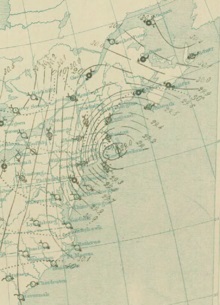 |
| Surface analysis of
the Great Blizzard of 1888. Areas with greater
isobaric packing indicate higher winds. |
Causes
The wind is caused by differences in atmospheric
pressure. When a difference in atmospheric pressure
exists, air moves from the higher to the lower pressure
area, resulting in winds of various speeds. On a
rotating planet, air will also be deflected by the
Coriolis effect, except exactly on the equator.
Globally, the two major driving factors of large-scale
wind patterns (the atmospheric circulation) are the
differential heating between the equator and the poles
(difference in absorption of solar energy leading to
buoyancy forces) and the rotation of the planet. Outside
the tropics and aloft from frictional effects of the
surface, the large-scale winds tend to approach
geostrophic balance. Near the Earth's surface, friction
causes the wind to be slower than it would be otherwise.
Surface friction also causes winds to blow more inward
into low-pressure areas.
Winds defined by an equilibrium of physical forces are
used in the decomposition and analysis of wind profiles.
They are useful for simplifying the atmospheric
equations of motion and for making qualitative arguments
about the horizontal and vertical distribution of winds.
The geostrophic wind component is the result of the
balance between Coriolis force and pressure gradient
force. It flows parallel to isobars and approximates the
flow above the atmospheric boundary layer in the
midlatitudes. The thermal wind is the difference in the
geostrophic wind between two levels in the atmosphere.
It exists only in an atmosphere with horizontal
temperature gradients. The ageostrophic wind component
is the difference between actual and geostrophic wind,
which is responsible for air "filling up" cyclones over
time. The gradient wind is similar to the geostrophic
wind but also includes centrifugal force (or centripetal
acceleration). |
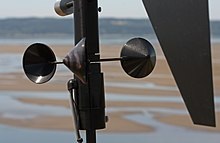 |
| Cup-type anemometer
with vertical axis, a sensor on a remote
meteorological station. |
Measurement
Wind direction is usually expressed in terms of the
direction from which it originates. For example, a
northerly wind blows from the north to the south.
Weather vanes pivot to indicate the direction of the
wind. At airports, windsocks indicate wind direction,
and can also be used to estimate wind speed by the angle
of hang. Wind speed is measured by anemometers, most
commonly using rotating cups or propellers. When a high
measurement frequency is needed (such as in research
applications), wind can be measured by the propagation
speed of ultrasound signals or by the effect of
ventilation on the resistance of a heated wire. Another
type of anemometer uses pitot tubes that take advantage
of the pressure differential between an inner tube and
an outer tube that is exposed to the wind to determine
the dynamic pressure, which is then used to compute the
wind speed.
Sustained wind speeds are reported globally at a 10
meters (33 ft) height and are averaged over a 10‑minute
time frame. The United States reports winds over a
1‑minute average for tropical cyclones, and a 2‑minute
average within weather observations. India typically
reports winds over a 3‑minute average. Knowing the wind
sampling average is important, as the value of a
one-minute sustained wind is typically 14% greater than
a ten-minute sustained wind. A short burst of high speed
wind is termed a wind gust, one technical definition of
a wind gust is: the maxima that exceed the lowest wind
speed measured during a ten-minute time interval by 10
knots (5 m/s) for periods of seconds. A squall is an
increase of the wind speed above a certain threshold,
which lasts for a minute or more.
To determine winds aloft, rawinsondes determine wind
speed by GPS, radio navigation, or radar tracking of the
probe. Alternatively, movement of the parent weather
balloon position can be tracked from the ground visually
using theodolites. Remote sensing techniques for wind
include SODAR, Doppler lidars and radars, which can
measure the Doppler shift of electromagnetic radiation
scattered or reflected off suspended aerosols or
molecules, and radiometers and radars can be used to
measure the surface roughness of the ocean from space or
airplanes. Ocean roughness can be used to estimate wind
velocity close to the sea surface over oceans.
Geostationary satellite imagery can be used to estimate
the winds throughout the atmosphere based upon how far
clouds move from one image to the next. Wind engineering
describes the study of the effects of the wind on the
built environment, including buildings, bridges and
other man-made objects. |
Wind force scale
Historically, the Beaufort wind force scale (created by
Beaufort) provides an empirical description of wind
speed based on observed sea conditions. Originally it
was a 13-level scale (0-12), but during the 1940s, the
scale was expanded to 18 levels (0-17). There are
general terms that differentiate winds of different
average speeds such as a breeze, a gale, a storm, or a
hurricane. Within the Beaufort scale, gale-force winds
lie between 28 knots (52 km/h) and 55 knots (102 km/h)
with preceding adjectives such as moderate, fresh,
strong, and whole used to differentiate the wind's
strength within the gale category. A storm has winds of
56 knots (104 km/h) to 63 knots (117 km/h). The
terminology for tropical cyclones differs from one
region to another globally. Most ocean basins use the
average wind speed to determine the tropical cyclone's
category. Below is a summary of the classifications used
by Regional Specialized Meteorological Centers
worldwide: |
|
Beaufort Scale |
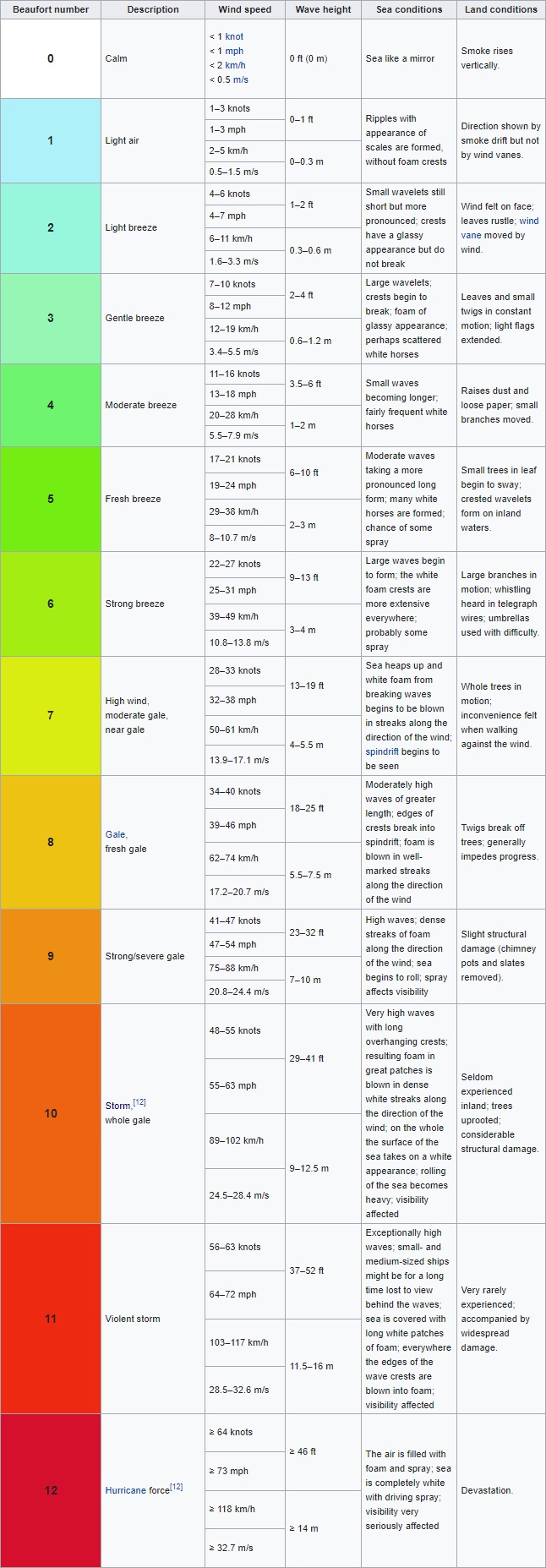 |
|
Enhanced Fujita scale
The Enhanced Fujita Scale (EF Scale) rates the strength
of tornadoes in the United States by using damage to
estimate wind speed. Below is the scale.
Saffir Simpson Scale
The Saffir–Simpson hurricane wind scale (SSHWS),
formerly the Saffir–Simpson hurricane scale (SSHS),
classifies hurricanes – Western Hemisphere tropical
cyclones – that exceed the intensities of tropical
depressions and tropical storms – into five categories
distinguished by the intensities of their sustained
winds. |
|
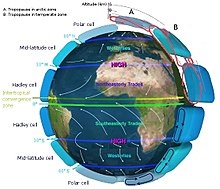 |
| Winds are part of
Earth's atmospheric circulation. |
Global climatology
Easterly winds, on average, dominate the flow pattern
across the poles, westerly winds blow across the
mid-latitudes of the earth, polewards of the subtropical
ridge, while easterlies again dominate the tropics.
Directly under the subtropical ridge are the doldrums,
or horse latitudes, where winds are lighter. Many of the
Earth's deserts lie near the average latitude of the
subtropical ridge, where descent reduces the relative
humidity of the air mass. The strongest winds are in the
mid-latitudes where cold polar air meets warm air from
the tropics.
Tropics
The trade winds (also called trades) are the prevailing
pattern of easterly surface winds found in the tropics
towards the Earth's equator. The trade winds blow
predominantly from the northeast in the Northern
Hemisphere and from the southeast in the Southern
Hemisphere. The trade winds act as the steering flow for
tropical cyclones that form over the world's oceans.
Trade winds also steer African dust westward across the
Atlantic Ocean into the Caribbean, as well as portions
of southeast North America.
A monsoon is a seasonal prevailing wind that lasts for
several months within tropical regions. The term was
first used in English in India, Bangladesh, Pakistan,
and neighboring countries to refer to the big seasonal
winds blowing from the Indian Ocean and Arabian Sea in
the southwest bringing heavy rainfall to the area. Its
poleward progression is accelerated by the development
of a heat low over the Asian, African, and North
American continents during May through July, and over
Australia in December. |
 |
| The westerlies and
trade winds. |
Westerlies and their impact
The Westerlies or the Prevailing Westerlies are the
prevailing winds in the middle latitudes between 35 and
65 degrees latitude. These prevailing winds blow from
the west to the east, and steer extratropical cyclones
in this general manner. The winds are predominantly from
the southwest in the Northern Hemisphere and from the
northwest in the Southern Hemisphere. They are strongest
in the winter when the pressure is lower over the poles,
and weakest during the summer and when pressures are
higher over the poles.
Together with the trade winds, the westerlies enabled a
round-trip trade route for sailing ships crossing the
Atlantic and Pacific Oceans, as the westerlies lead to
the development of strong ocean currents on the western
sides of oceans in both hemispheres through the process
of western intensification. These western ocean currents
transport warm, sub-tropical water polewards toward the
polar regions. The westerlies can be particularly
strong, especially in the southern hemisphere, where
there is less land in the middle latitudes to cause the
flow pattern to amplify, which slows the winds down. The
strongest westerly winds in the middle latitudes are
within a band known as the Roaring Forties, between 40
and 50 degrees latitude south of the equator. The
Westerlies play an important role in carrying the warm,
equatorial waters and winds to the western coasts of
continents, especially in the southern hemisphere
because of its vast oceanic expanse.
Polar easterlies
The polar easterlies, also known as Polar Hadley cells,
are dry, cold prevailing winds that blow from the
high-pressure areas of the polar highs at the north and
south poles towards the low-pressure areas within the
Westerlies at high latitudes. Unlike the Westerlies,
these prevailing winds blow from the east to the west,
and are often weak and irregular. Because of the low sun
angle, cold air builds up and subsides at the pole
creating surface high-pressure areas, forcing an
equatorward outflow of air; that outflow is deflected
westward by the Coriolis effect. |
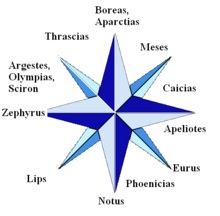 |
| Winds according to
Aristotle. |
Usage
History
As a natural force, the wind was often personified as
one or more wind gods or as an expression of the
supernatural in many cultures. Vayu is the Hindu God of
Wind. The Greek wind gods include Boreas, Notus, Eurus,
and Zephyrus. Aeolus, in varying interpretations the
ruler or keeper of the four winds, has also been
described as Astraeus, the god of dusk who fathered the
four winds with Eos, goddess of dawn. The ancient Greeks
also observed the seasonal change of the winds, as
evidenced by the Tower of the Winds in Athens. Venti are
the Roman gods of the winds. Fūjin is the Japanese wind
god and is one of the eldest Shinto gods. According to
legend, he was present at the creation of the world and
first let the winds out of his bag to clear the world of
mist. In Norse mythology, Njörðr is the god of the wind.
There are also four dvärgar (Norse dwarves), named
Norðri, Suðri, Austri and Vestri, and probably the four
stags of Yggdrasil, personify the four winds, and
parallel the four Greek wind gods. Stribog is the name
of the Slavic god of winds, sky and air. He is said to
be the ancestor (grandfather) of the winds of the eight
directions.
Kamikaze (神風) is a Japanese word, usually translated as
divine wind, believed to be a gift from the gods. The
term is first known to have been used as the name of a
pair or series of typhoons that are said to have saved
Japan from two Mongol fleets under Kublai Khan that
attacked Japan in 1274 and again in 1281. Protestant
Wind is a name for the storm that deterred the Spanish
Armada from an invasion of England in 1588 where the
wind played a pivotal role, or the favorable winds that
enabled William of Orange to invade England in 1688.
During Napoleon's Egyptian Campaign, the French soldiers
had a hard time with the khamsin wind: when the storm
appeared "as a blood-stint in the distant sky", the
Ottomans went to take cover, while the French "did not
react until it was too late, then choked and fainted in
the blinding, suffocating walls of dust". During the
North African Campaign of the World War II, "allied and
German troops were several times forced to halt in
mid-battle because of sandstorms caused by khamsin ...
Grains of sand whirled by the wind blinded the soldiers
and created electrical disturbances that rendered
compasses useless."
Transportation
There are many different forms of sailing ships, but
they all have certain basic things in common. Except for
rotor ships using the Magnus effect, every sailing ship
has a hull, rigging and at least one mast to hold up the
sails that use the wind to power the ship. Ocean
journeys by sailing ship can take many months, and a
common hazard is becoming becalmed because of lack of
wind, or being blown off course by severe storms or
winds that do not allow progress in the desired
direction. A severe storm could lead to shipwreck, and
the loss of all hands. Sailing ships can only carry a
certain quantity of supplies in their hold, so they have
to plan long voyages carefully to include appropriate
provisions, including fresh water.
For aerodynamic aircraft which operate relative to the
air, winds affect groundspeed, and in the case of
lighter-than-air vehicles, wind may play a significant
or solitary role in their movement and ground track. The
velocity of surface wind is generally the primary factor
governing the direction of flight operations at an
airport, and airfield runways are aligned to account for
the common wind direction(s) of the local area. While
taking off with a tailwind may be necessary under
certain circumstances, a headwind is generally
desirable. A tailwind increases takeoff distance
required and decreases the climb gradient. |
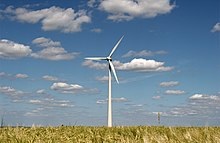 |
| This wind turbine
generates electricity from wind power. |
Power source
Historically, the ancient Sinhalese of Anuradhapura and
in other cities around Sri Lanka used the monsoon winds
to power furnaces as early as 300 BCE. The furnaces were
constructed on the path of the monsoon winds to exploit
the wind power, to bring the temperatures inside up to
1,200 °C (2,190 °F). A rudimentary windmill was used to
power an organ in the first century CE. The first
practical windmills were later built in Sistan,
Afghanistan, from the 7th century CE. These were
vertical-axle windmills, which had long vertical
driveshafts with rectangle shaped blades. Made of six to
twelve sails covered in reed matting or cloth material,
these windmills were used to grind corn and draw up
water, and were used in the gristmilling and sugarcane
industries. Horizontal-axle windmills were later used
extensively in Northwestern Europe to grind flour
beginning in the 1180s, and many Dutch windmills still
exist. High altitude wind power is the focus of over 30
companies worldwide using tethered technology rather
than ground-hugging compressive-towers. Oil is being
saved by using wind for powering cargo ships by use of
the mechanical energy converted from the wind's kinetic
energy using very large kites.
Recreation
Wind figures prominently in several popular sports,
including recreational hang gliding, hot air ballooning,
kite flying, snowkiting, kite landboarding, kite
surfing, paragliding, sailing, and windsurfing. In
gliding, wind gradients just above the surface affect
the takeoff and landing phases of flight of a glider.
Wind gradient can have a noticeable effect on ground
launches, also known as winch launches or wire launches.
If the wind gradient is significant or sudden, or both,
and the pilot maintains the same pitch attitude, the
indicated airspeed will increase, possibly exceeding the
maximum ground launch tow speed. The pilot must adjust
the airspeed to deal with the effect of the gradient.
When landing, wind shear is also a hazard, particularly
when the winds are strong. As the glider descends
through the wind gradient on final approach to landing,
airspeed decreases while sink rate increases, and there
is insufficient time to accelerate prior to ground
contact. The pilot must anticipate the wind gradient and
use a higher approach speed to compensate for it. |
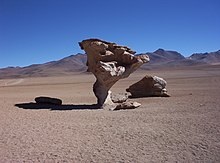 |
| A rock formation in
the Altiplano, Bolivia, sculpted by wind
erosion. |
Role in the
natural world
In arid climates, the main source of erosion is wind.
The general wind circulation moves small particulates
such as dust across wide oceans thousands of kilometers
downwind of their point of origin, which is known as
deflation. Westerly winds in the mid-latitudes of the
planet drive the movement of ocean currents from west to
east across the world's oceans. Wind has a very
important role in aiding plants and other immobile
organisms in dispersal of seeds, spores, pollen, etc.
Although wind is not the primary form of seed dispersal
in plants, it provides dispersal for a large percentage
of the biomass of land plants.
Erosion
Erosion can be the result of material movement by the
wind. There are two main effects. First, wind causes
small particles to be lifted and therefore moved to
another region. This is called deflation. Second, these
suspended particles may impact on solid objects causing
erosion by abrasion (ecological succession). Wind
erosion generally occurs in areas with little or no
vegetation, often in areas where there is insufficient
rainfall to support vegetation. An example is the
formation of sand dunes, on a beach or in a desert.
Loess is a homogeneous, typically nonstratified, porous,
friable, slightly coherent, often calcareous,
fine-grained, silty, pale yellow or buff, windblown
(Aeolian) sediment. It generally occurs as a widespread
blanket deposit that covers areas of hundreds of square
kilometers and tens of meters thick. Loess often stands
in either steep or vertical faces. Loess tends to
develop into highly rich soils. Under appropriate
climatic conditions, areas with loess are among the most
agriculturally productive in the world. Loess deposits
are geologically unstable by nature, and will erode very
readily. Therefore, windbreaks (such as big trees and
bushes) are often planted by farmers to reduce the wind
erosion of loess.
Desert dust migration
During mid-summer (July in the northern hemisphere), the
westward-moving trade winds south of the
northward-moving subtropical ridge expand northwestward
from the Caribbean into southeastern North America. When
dust from the Sahara moving around the southern
periphery of the ridge within the belt of trade winds
moves over land, rainfall is suppressed and the sky
changes from a blue to a white appearance, which leads
to an increase in red sunsets. Its presence negatively
impacts air quality by adding to the count of airborne
particulates. Over 50% of the African dust that reaches
the United States affects Florida. Since 1970, dust
outbreaks have worsened because of periods of drought in
Africa. There is a large variability in the dust
transport to the Caribbean and Florida from year to
year. Dust events have been linked to a decline in the
health of coral reefs across the Caribbean and Florida,
primarily since the 1970s. Similar dust plumes originate
in the Gobi Desert, which combined with pollutants,
spread large distances downwind, or eastward, into North
America.
There are local names for winds associated with sand and
dust storms. The Calima carries dust on southeast winds
into the Canary islands. The Harmattan carries dust
during the winter into the Gulf of Guinea. The Sirocco
brings dust from north Africa into southern Europe
because of the movement of extratropical cyclones
through the Mediterranean. Spring storm systems moving
across the eastern Mediterranean Sea cause dust to carry
across Egypt and the Arabian peninsula, which are
locally known as Khamsin. The Shamal is caused by cold
fronts lifting dust into the atmosphere for days at a
time across the Persian Gulf states. |
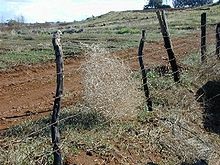 |
| Tumbleweed blown
against a fence. |
Effect on plants
Wind dispersal of seeds, or anemochory, is one of the
more primitive means of dispersal. Wind dispersal can
take on one of two primary forms: seeds can float on the
breeze or alternatively, they can flutter to the ground.
The classic examples of these dispersal mechanisms
include dandelions (Taraxacum spp., Asteraceae), which
have a feathery pappus attached to their seeds and can
be dispersed long distances, and maples (Acer (genus)
spp., Sapindaceae), which have winged seeds and flutter
to the ground. An important constraint on wind dispersal
is the need for abundant seed production to maximize the
likelihood of a seed landing in a site suitable for
germination. There are also strong evolutionary
constraints on this dispersal mechanism. For instance,
species in the Asteraceae on islands tended to have
reduced dispersal capabilities (i.e., larger seed mass
and smaller pappus) relative to the same species on the
mainland. Reliance upon wind dispersal is common among
many weedy or ruderal species. Unusual mechanisms of
wind dispersal include tumbleweeds. A related process to
anemochory is anemophily, which is the process where
pollen is distributed by wind. Large families of plants
are pollinated in this manner, which is favored when
individuals of the dominant plant species are spaced
closely together.
Wind also limits tree growth. On coasts and isolated
mountains, the tree line is often much lower than in
corresponding altitudes inland and in larger, more
complex mountain systems, because strong winds reduce
tree growth. High winds scour away thin soils through
erosion, as well as damage limbs and twigs. When high
winds knock down or uproot trees, the process is known
as windthrow. This is most likely on windward slopes of
mountains, with severe cases generally occurring to tree
stands that are 75 years or older. Plant varieties near
the coast, such as the Sitka spruce and sea grape, are
pruned back by wind and salt spray near the coastline.
Wind can also cause plants damage through sand abrasion.
Strong winds will pick up loose sand and topsoil and
hurl it through the air at speeds ranging from 25 miles
per hour (40 km/h) to 40 miles per hour (64 km/h). Such
windblown sand causes extensive damage to plant
seedlings because it ruptures plant cells, making them
vulnerable to evaporation and drought. Using a
mechanical sandblaster in a laboratory setting,
scientists affiliated with the Agricultural Research
Service studied the effects of windblown sand abrasion
on cotton seedlings. The study showed that the seedlings
responded to the damage created by the windblown sand
abrasion by shifting energy from stem and root growth to
the growth and repair of the damaged stems. After a
period of four weeks, the growth of the seedling once
again became uniform throughout the plant, as it was
before the windblown sand abrasion occurred.
Effect on animals
Cattle and sheep are prone to wind chill caused by a
combination of wind and cold temperatures, when winds
exceed 40 kilometers per hour (25 mph), rendering their
hair and wool coverings ineffective. Although penguins
use both a layer of fat and feathers to help guard
against coldness in both water and air, their flippers
and feet are less immune to the cold. In the coldest
climates such as Antarctica, emperor penguins use
huddling behavior to survive the wind and cold,
continuously alternating the members on the outside of
the assembled group, which reduces heat loss by 50%.
Flying insects, a subset of arthropods, are swept along
by the prevailing winds, while birds follow their own
course taking advantage of wind conditions, in order to
either fly or glide. As such, fine line patterns within
weather radar imagery, associated with converging winds,
are dominated by insect returns. Bird migration, which
tends to occur overnight within the lowest 7,000 feet
(2,100 m) of the Earth's atmosphere, contaminates wind
profiles gathered by weather radar, particularly the
WSR-88D, by increasing the environmental wind returns by
15 knots (28 km/h) to 30 knots (56 km/h).
Pikas use a wall of pebbles to store dry plants and
grasses for the winter in order to protect the food from
being blown away. Cockroaches use slight winds that
precede the attacks of potential predators, such as
toads, to survive their encounters. Their cerci are very
sensitive to the wind, and help them survive half of
their attacks. Elk have a keen sense of smell that can
detect potential upwind predators at a distance of 0.5
miles (800 m). Increases in wind above 15 kilometers per
hour (9.3 mph) signals glaucous gulls to increase their
foraging and aerial attacks on thick-billed murres.
Sound generation
Wind causes the generation of sound. The movement of air
causes movements of parts of natural objects, such as
leaves or grass. These objects will produce sound if
they touch each other. Even a soft wind will cause a low
level of environmental noise. If the wind is blowing
harder, it may produce howling sounds of varying
frequencies. This may be caused by the wind blowing over
cavities, or by vortices created in the air downstream
of an object. Especially on high buildings, many
structural parts may be a cause of annoying noise at
certain wind conditions. Examples of these parts are
balconies, ventilation openings, roof openings or
cables. |
|
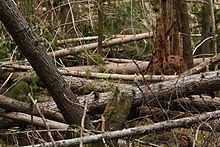 |
| In the montane
forest of Olympic National Park, windthrow opens
the canopy and increases light intensity on the
understory. |
Related damage
High winds are known to cause damage, depending upon the
magnitude of their velocity and pressure differential.
Wind pressures are positive on the windward side of a
structure and negative on the leeward side. Infrequent
wind gusts can cause poorly designed suspension bridges
to sway. When wind gusts are at a similar frequency to
the swaying of the bridge, the bridge can be destroyed
more easily, such as what occurred with the Tacoma
Narrows Bridge in 1940. Wind speeds as low as 23 knots
(43 km/h) can lead to power outages due to tree branches
disrupting the flow of energy through power lines. While
no species of tree is guaranteed to stand up to
hurricane-force winds, those with shallow roots are more
prone to uproot, and brittle trees such as eucalyptus,
sea hibiscus, and avocado are more prone to damage.
Hurricane-force winds cause substantial damage to mobile
homes, and begin to structurally damage homes with
foundations. Winds of this strength due to downsloped
winds off terrain have been known to shatter windows and
sandblast paint from cars. Once winds exceed 135 knots
(250 km/h), homes completely collapse, and significant
damage is done to larger buildings. Total destruction to
man-made structures occurs when winds reach 175 knots
(324 km/h). The Saffir–Simpson scale and Enhanced Fujita
scale were designed to help estimate wind speed from the
damage caused by high winds related to tropical cyclones
and tornadoes, and vice versa.
Australia's Barrow Island holds the record for the
strongest wind gust, reaching 408 km/h (253 mph) during
tropical cyclone Olivia on 10 April 1996, surpassing the
previous record of 372 km/h (231 mph) set on Mount
Washington (New Hampshire) on the afternoon of 12 April
1934. The most powerful gusts of wind on Earth were
created by nuclear detonations. The blast wave is
similar to a strong wind gust over the ground. The
largest nuclear explosion (50–58 megatons at an altitude
of about 13,000 feet (4,000 m)) generated a 20 bar blast
pressure at ground zero, which is similar to a wind gust
of 3,100 miles per hour (5,000 km/h).
Wildfire intensity increases during daytime hours. For
example, burn rates of smoldering logs are up to five
times greater during the day because of lower humidity,
increased temperatures, and increased wind speeds.
Sunlight warms the ground during the day and causes air
currents to travel uphill, and downhill during the night
as the land cools. Wildfires are fanned by these winds
and often follow the air currents over hills and through
valleys. United States wildfire operations revolve
around a 24-hour fire day that begins at 10:00 a.m.
because of the predictable increase in intensity
resulting from the daytime warmth. |
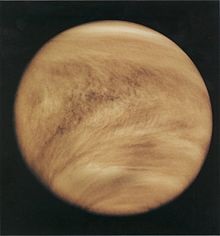 |
| Possible future for
Earth due to the planetary wind: Venus. |
In outer space
The solar wind is quite different from a terrestrial
wind, in that its origin is the sun, and it is composed
of charged particles that have escaped the sun's
atmosphere. Similar to the solar wind, the planetary
wind is composed of light gases that escape planetary
atmospheres. Over long periods of time, the planetary
wind can radically change the composition of planetary
atmospheres.
The fastest wind ever recorded is coming from the
accretion disc of the IGR J17091-3624 black hole. Its
speed is 20,000,000 miles per hour (32,000,000 km/h),
which is 3% of the speed of light.
Planetary wind
The hydrodynamic wind within the upper portion of a
planet's atmosphere allows light chemical elements such
as hydrogen to move up to the exobase, the lower limit
of the exosphere, where the gases can then reach escape
velocity, entering outer space without impacting other
particles of gas. This type of gas loss from a planet
into space is known as planetary wind. Such a process
over geologic time causes water-rich planets such as the
Earth to evolve into planets like Venus. Additionally,
planets with hotter lower atmospheres could accelerate
the loss rate of hydrogen.
Solar wind
Rather than air, the solar wind is a stream of charged
particles—a plasma—ejected from the upper atmosphere of
the sun at a rate of 400 kilometers per second (890,000
mph). It consists mostly of electrons and protons with
energies of about 1 keV. The stream of particles varies
in temperature and speed with the passage of time. These
particles are able to escape the sun's gravity, in part
because of the high temperature of the corona, but also
because of high kinetic energy that particles gain
through a process that is not well understood. The solar
wind creates the Heliosphere, a vast bubble in the
interstellar medium surrounding the Solar System.
Planets require large magnetic fields in order to reduce
the ionization of their upper atmosphere by the solar
wind. Other phenomena caused by the solar wind include
geomagnetic storms that can knock out power grids on
Earth, the aurorae such as the Northern Lights, and the
plasma tails of comets that always point away from the
sun.
On other planets
Strong 300 kilometers per hour (190 mph) winds at
Venus's cloud tops circle the planet every four to five
earth days. When the poles of Mars are exposed to
sunlight after their winter, the frozen CO2 sublimates,
creating significant winds that sweep off the poles as
fast as 400 kilometers per hour (250 mph), which
subsequently transports large amounts of dust and water
vapor over its landscape. Other Martian winds have
resulted in cleaning events and dust devils. On Jupiter,
wind speeds of 100 meters per second (220 mph) are
common in zonal jet streams. Saturn's winds are among
the Solar System's fastest. Cassini–Huygens data
indicated peak easterly winds of 375 meters per second
(840 mph). On Uranus, northern hemisphere wind speeds
reach as high as 240 meters per second (540 mph) near 50
degrees north latitude. At the cloud tops of Neptune,
prevailing winds range in speed from 400 meters per
second (890 mph) along the equator to 250 meters per
second (560 mph) at the poles. At 70° S latitude on
Neptune, a high-speed jet stream travels at a speed of
300 meters per second (670 mph). The fastest wind on any
known planet is on HD 80606 b located 190 light years
away, where it blows at more than 11,000 mph or 5 km/s. |
|
|
|